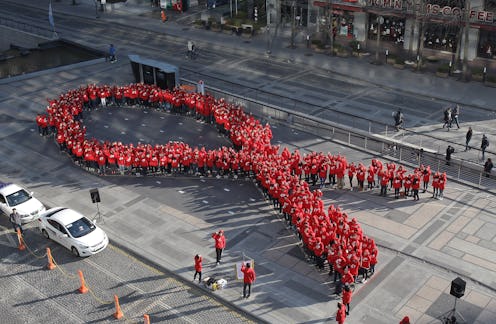Life
A Second Patient Has Been Cured Of HIV, According To A New Report

For the second known time in history, an HIV-positive patient is reportedly “cured” of the AIDS-causing virus, according to Reuters. The anonymous “London patient,” as scientists have dubbed him, was the recipient of a bone-marrow transplant nearly three years ago from a donor who was HIV-resistant. The donor’s bone-marrow stem cells featured a rare genetic mutation resistant to HIV infection, and the patient was taken off antiretroviral drugs more than a year and a half ago. Now, the team of doctors treating him say that tests are showing no indications of the man’s prior HIV infection.
“There is no virus there that we can measure. We can’t detect anything,” Professor Ravindra Gupta, an HIV biologist co-leading the team treating the patient, told Reuters. But while Gupta described the patient as “in remission” and “functionally cured,” he advised that it is still too soon to say that the the patient is definitively cured. The London patient, who contracted HIV in 2003, was diagnosed with blood cancer called Hodgkin’s Lymphoma in 2012. In 2016, he was able to get the transplant as his "last chance of survival,” Gupta told Reuters.
In the United States, roughly 1.1 million people are living with HIV, with around one in seven of them unaware of their infection, according to the U.S. Department of Health & Human Services. The population most affected by HIV is bisexual and gay men, who account for roughly 66 percent of diagnoses in 2017, per data from the Centers for Disease Control and Prevention. Black and Latinx people are disproportionately affected by the virus, and the CDC also estimates that people who use injectable drugs accounted for another 6 percent of diagnoses in 2017. Globally, approximately 37 million people worldwide have HIV/AIDS, with 5 percent of cases occurring in children, according to UNAIDS.
This is the second time a patient has been reported "cured" of HIV, thanks also to a bone-marrow transplant that was originally intended to treat cancer. The first known case of an HIV “cure” occurred in 2007, when “Berlin patient” Timothy Brown, an American man living in Germany, experienced a similar treatment that appeared to clear his HIV. Brown is still HIV-free, according to the journal Science. In both cases, the HIV-resistant blood cells from the transplants replaced the patients’ infected cells, Science explains, and the patients were able to cease taking the antiretroviral drugs that were previously necessary to mitigate their infections.
Doctors are still trying to understand the exact mechanics behind both the London and Berlin patient cases. They noted that the procedure they used for the London patient may not be possible to replicate on a mass scale due to its cost, complexity, and the rarity of finding compatible donors with the HIV-resistant gene mutation, not to mention the invasiveness of the procedure compared with existing antiretroviral drugs that can drastically reduce a patient's viral load. “Although this is not a viable large-scale strategy for a cure, it does represent a critical moment,” Anton Pozniak, president of the International AIDS Society, told Reuters. “The hope is that this will eventually lead to a safe, cost-effective and easy strategy...using gene technology or antibody techniques.”
The case hints at a future where some day scientists may be able to end the global epidemic, as well as opens up avenues for developing new potential HIV treatment strategies. “This will inspire people that cure is not a dream,” Dr. Annemarie Wensing, a virologist based in the Netherlands, told The New York Times. “It’s reachable.”